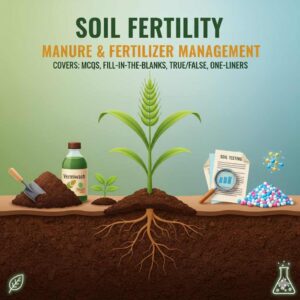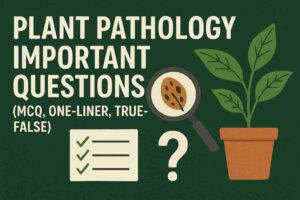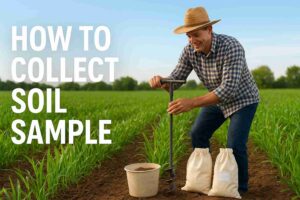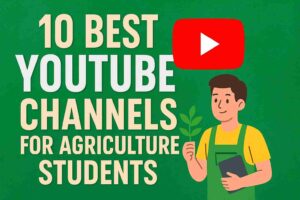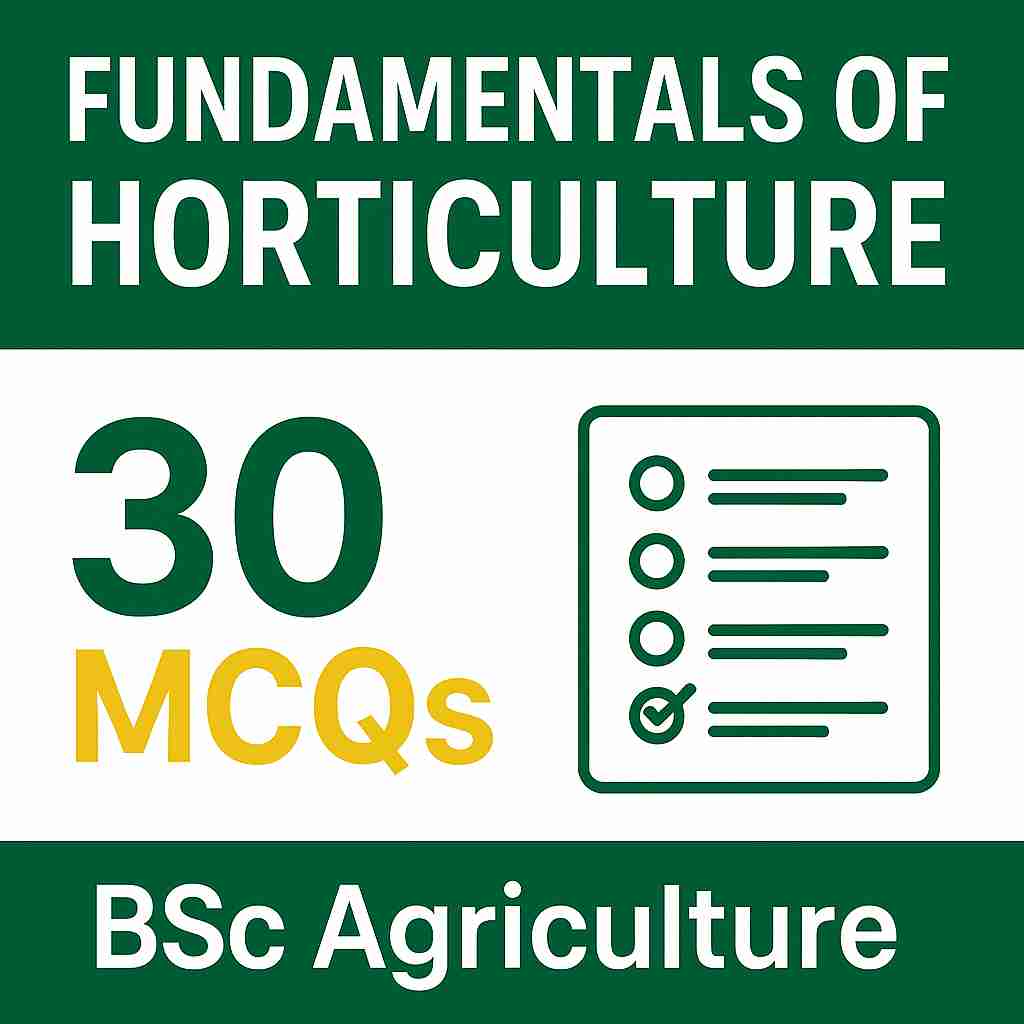
"Fundamentals of Horticulture MCQs with Explanations for BSc Agriculture"
Are you preparing for BSc Agriculture exams and looking for Fundamentals of Horticulture MCQs with explanations for BSc Agriculture? You’re at the right place!
In this post, we have compiled the 30 most important and exam-relevant MCQs from the subject Fundamentals of Horticulture based on the 6th Dean Committee syllabus. These questions are carefully selected to cover theoretical concepts, numerical logic, and fact-based learning – making them perfect for semester exams, competitive agriculture exams, and quick revision.
Each question is followed by a detailed explanation to help you understand not just the correct answer, but also the concept behind it. Whether you’re a first-semester student or preparing for exams like ICAR, JRF, or state-level agriculture exams, these MCQs will give you a solid conceptual grip on horticulture.
Let’s test your knowledge and build strong fundamentals in horticulture!
Fundamentals of Horticulture MCQs with Explanations PDF Download
Q.1 Which of the following branches of horticulture deals with the cultivation of fruits?
a) Olericulture
b) Pomology
c) Floriculture
d) Plantation crops
📝 Additional Information
Horticulture is the science of growing garden crops like fruits, vegetables, and flowers. It’s divided into different branches based on crop types:
Olericulture is all about vegetables — like tomato, spinach, and brinjal.
Pomology deals specifically with fruits, such as mango, banana, guava, etc.
Floriculture is for flower cultivation — roses, marigolds, etc.
Plantation crops include large-scale crops like tea, coffee, and coconut.
👉 So, if the question is about fruit cultivation, the correct answer is Pomology.
Q.2 Which of the following classifications is based on plant parts like root, stem, and leaf?
a) Botanical classification
b) Climatic classification
c) Horticultural classification
d) Economic classification
📝 Additional Information
Botanical classification is the scientific way of grouping plants based on their structure and parts—like roots, stems, leaves, flowers, and seeds.
It uses features such as flower structure and leaf type to place plants into families (e.g., Solanaceae for tomato and brinjal).
This helps in scientific naming and research.
Other options, like horticultural classification, group crops based on usage (fruits, vegetables, etc.), not structure.
Q.3 Which type of soil is most suitable for growing horticultural crops?
a) Sandy soil
b) Clay soil
c) Loamy soil
d) Laterite soil
📝 Additional Information
Loamy soil is often called the “ideal soil” for most crops. Why?
Because it’s a perfect mix of sand, silt, and clay — which means:
It holds moisture, but doesn’t get waterlogged.
It allows air to reach the roots.
It’s rich in nutrients and easy to work with.
Sandy soil drains too fast, and clay soil holds too much water — both are not ideal for most horticultural crops.
👉 That’s why loamy soil is considered the best.
Q.4 Which of the following is a method of asexual propagation?
a) Sowing seeds
b) Grafting
c) Cross-pollination
d) Seed treatment
📝 Additional Information
Asexual propagation means creating new plants without using seeds.
Grafting is one such method where the shoot of one plant (scion) is attached to the root of another (stock).
This method is commonly used in fruit crops like mango, citrus, and guava to maintain fruit quality and uniformity.
On the other hand:
Sowing seeds and cross-pollination are part of sexual propagation.
Seed treatment improves germination but is not a method of propagation.
Q.5 What is the main advantage of asexual propagation over sexual propagation?
a) It produces stronger seeds
b) It increases seed dormancy
c) It produces genetically identical plants
d) It takes more time to grow
📝 Additional Information
In asexual propagation, the new plant is like a photocopy of the parent plant — same fruit size, color, and yield.
This is very useful when we want to maintain specific traits in fruits or flowers.
In contrast, sexual propagation (by seeds) creates variation—which might give different quality or delayed maturity.
👉 So, if uniformity and exact quality are the goals, asexual propagation is the best option.
Q.6 Which of the following structures is commonly used to protect nursery plants during propagation?
a) Drip irrigation unit
b) Open field
c) Shade net house
d) Combine harvester
📝 Additional Information
Young nursery plants need a safe and controlled environment to grow properly.
Shade net houses are special structures covered with a green or black net. They protect plants from harsh sunlight, heavy rain, wind, and insects.
A drip irrigation unit only helps in watering, not protection.
An open field exposes the plants to environmental stress.
A combine harvester is for harvesting, not propagation.
👉 That’s why, for raising healthy nursery plants, a shade net house is the right answer.
Q.7 While establishing a fruit orchard, which factor is considered most important?
a) Type of insecticide used
b) Distance from city
c) Soil drainage and depth
d) Availability of packaging material
📝 Additional Information
Orchards are long-term investments—once you plant trees, they stay for decades.
That’s why the soil must be deep, fertile, and well-drained. If the soil retains water, roots may rot, and plant health will decline.
Other factors, such as packaging material, insecticides, or distance from the city, can be managed later, but if the soil is poor, the orchard will never succeed.
👉 So, always check soil quality and drainage before planting fruit crops.
Q.8 What is the main goal of training in horticultural crops?
a) Weed removal
b) Increasing leaf size
c) Shaping the plant and improving sunlight exposure
d) Seed hardening
📝 Additional Information
Training means guiding the plant’s growth in a specific direction or shape.
In fruit crops, this helps in:
Allowing sunlight to reach all parts of the plant
Giving strength and balance to the plant structure
Making spraying and harvesting easier
Open-center or central leader training methods are common in mango, guava, and other similar crops.
Options like weed removal and seed hardening have no direct link with this technique.
👉 So, the correct goal of training is a better shape + sunlight exposure.
Q.9 In horticultural crops, the juvenile stage is when the plant:
a) Produces fruit early
b) Remains dormant during winter
c) Does not produce flowers or fruits
d) Starts vegetative propagation
📝 Additional Information
Every plant has a juvenile phase — it’s like childhood in humans.
In this stage, the plant grows actively but does not flower or bear fruit, no matter how healthy it looks.
For example, a mango plant raised from seed may take 5–7 years to exit juvenile stage and start fruiting.
This is very important to know in orchard planning — because during this time, you need patience and care without expecting yield.
👉 So, no flowering or fruiting during juvenility is the key point.
Q.10 Which of the following is a major cause of unfruitfulness in horticultural crops?
a) Proper training
b) Balanced fertilisation
c) Lack of pollination
d) Good irrigation
📝 Additional Information
Sometimes fruit trees grow well but do not produce fruit—this is called unfruitfulness.
One of the most common reasons is poor pollination—when pollen doesn’t reach the stigma, fertilisation doesn’t happen, and hence, no fruit sets.
This may happen due to:
Lack of pollinators (like bees)
Absence of a compatible polliniser variety
Bad weather during flowering
Balanced nutrition, irrigation, or pruning can’t fix this if pollination fails.
👉 So, to ensure fruit set, proper pollination is essential.
Q.11 What is the ideal planting distance (in meters) for mango trees in a traditional orchard system?
a) 4 × 4
b) 6 × 6
c) 7 × 7
d) 10 × 10
📝 Additional Information
Mango trees grow very large and spread widely. In traditional orchard systems (not high-density), they need ample space to grow fully and allow airflow.
So the recommended spacing is 10 meters × 10 meters.
Closer spacing, like 6×6, may cause overcrowding later
High-density orchards use closer spacing but need dwarf varieties & training systems
👉 For regular mango farming, always remember: 10m × 10m = ideal spacing
Q.12 Which plant growth regulator (PGR) is commonly used to promote flowering in pineapples?
a) IAA
b) Cytokinin
c) Ethylene
d) ABA
📝 Additional Information
In commercial pineapple farming, ethylene or ethrel (a source of ethylene) is sprayed to induce uniform flowering. This is especially useful because pineapple naturally flowers late or irregularly.
IAA (auxin) is for cell elongation
Cytokinin promotes cell division
ABA induces dormancy
👉 So, for flowering in pineapples: Ethylene is the key PGR
Q.13 A citrus grower reports that fruit is developing without fertilization. What is this phenomenon called?
a) Pollination
b) Parthenocarpy
c) Dormancy
d) Vernalization
📝 Additional Information
Parthenocarpy is when fruits develop without fertilization, so they have no seeds. It’s a naturally occurring or artificially induced process.
Example:
Seedless banana, seedless guava, seedless citrus
This is useful in commercial farming for consumer preference and uniform yield.
👉 So, fruit without seed formation = Parthenocarpy
Q.14 Which method of irrigation saves the most water and is best for fruit orchards?
a) Basin irrigation
b) Flood irrigation
c) Drip irrigation
d) Sprinkler irrigation
📝 Additional Information
Drip irrigation provides water directly to the root zone drop by drop, which:
Saves up to 60–70% of water
Reduces weed growth
Prevents waterlogging
It is ideal for orchards and high-value crops
Flood irrigation wastes water and causes nutrient leaching. Sprinklers are better for short crops.
👉 Best method for water saving + orchard efficiency = Drip irrigation
Q.15 A farmer applies fertilizers but sees poor growth in plants. Which mistake might be responsible?
a) Applying fertilizers in the evening
b) Broadcasting fertilizers during heavy rain
c) Using organic manure
d) Avoiding chemical sprays
📝 Additional Information
If fertilizers are broadcasted during heavy rainfall, they get washed away before plants can absorb them. This leads to nutrient loss and poor plant growth.
Correct practices include:
Applying before light irrigation
Using ring method or fertigation
Avoiding rainy conditions
👉 So, rain + fertilizer = wastage. Hence, option b is correct.
Q.16 Which of the following fruit crops is self-incompatible and requires a pollinizer for fruit set?
a) Guava
b) Mango
c) Apple
d) Papaya
📝 Additional Information
Apple is self-incompatible — iska matlab hai ki apna pollen khud ke flower ko fertilize nahi kar sakta.
Isliye orchard me pollinizer varieties (like Golden Delicious, Granny Smith) lagani padti hai jo compatible pollen de sake.
Also, pollinators (like bees) are needed to transfer pollen.
Guava and mango are mostly self-pollinated.
Papaya has male, female, and hermaphrodite plants — a different system.
👉 So, self-incompatibility + pollinizer need = Apple
Q.17 Calculate the number of mango trees that can be planted in a 1-hectare orchard with a spacing of 10 × 10
a) 100
b) 120
c) 90
d) 150
📝 Additional Information
Total area of 1 hectare = 10,000 square meters
Spacing = 10m × 10m = 100 sq. meters per tree
So, number of trees = 10,000 ÷ 100 = 100 trees
👉 Always remember: in traditional mango orchards (10×10 spacing), 100 trees per hectare is the standard answer.
Q.18 Which of the following is a natural pollinator essential for fruit crops like apple and watermelon?
a) Earthworm
b) Honeybee
c) Butterfly
d) Spider
📝 Additional Information
Honeybees are considered the most efficient natural pollinators for many fruit crops, like
Apple
Watermelon
Melon
Citrus
Their body structure and regular flower visits help transfer pollen accurately.
Other insects like butterflies help a little, but bees are key.
👉 So, if you want a good fruit set, keep the bees happy 🐝
Q.19 Which of the following fruit crops shows parthenocarpy naturally (without any hormone treatment)?
a) Mango
b) Banana
c) Apple
d) Litchi
📝 Additional Information
Parthenocarpy = fruit without fertilisation = no seeds.
Some crops need hormone sprays for this, but bananas are naturally parthenocarpic — that’s why we enjoy seedless bananas.Mango and apple require fertilisation.
Litchi also has seeds.
Only the banana produces fruit without seeds naturally.
👉 Seedless + natural = Banana is the correct choice
Upcoming agriculture exams 2025
Q.20 Which is the most effective method of fertilizer application in young fruit plants?
a) Broadcasting
b) Foliar spray
c) Ring method
d) Flooding
📝 Additional Information
Compacted soils have fewer pores, reducing water movement.
Roots struggle to penetrate compacted soil.
Q.21 Which of the following is the correct sign of maturity in mango?
a) Fruit turns black on one side
b) Fruit develops a hollow sound when tapped
c) Fruit becomes hard and green
d) Fruit starts falling with leaves
📝 Additional Information
Mango maturity is identified by a dull skin appearance and when tapped, the fruit gives a hollow, dull sound — a sign that pulp has developed fully.
Other signs may include:
Shoulder development
Change in colour from deep green to light yellowish
Fruit falling with leaves = over-ripeness or disease.
👉 So,the hollow sound is a trusted field test for mango harvest.
Q.22 What is the technical term for the process when a vegetative bud changes into a flower bud?
a) Vernalization
b) Fertilization
c) Flower bud differentiation
d) Juvenility
📝 Additional Information
In perennial fruit crops like mango, citrus, and guava — plants initially produce vegetative growth (leaves, shoots).
When the plant prepares for flowering, some buds differentiate and turn into flower buds — this process is called flower bud differentiation.
This is influenced by:
Plant age
Weather
Hormones and nutrition
👉 This process is key to flowering and fruiting.
Q.23 Which plant growth regulator is commonly used to delay fruit ripening and extend shelf life?
a) Ethylene
b) GA₃ (Gibberellic acid)
c) ABA
d) Cytokinin
📝 Additional Information
GA₃ is a growth hormone that delays senescence (aging). In fruits like grapes, oranges, and bananas, GA₃ spray can delay ripening, allowing for:
Longer shelf life
Better appearance
Extended marketability
Ethylene speeds up ripening
ABA helps in dormancy
Cytokinin helps in cell division, but not in delaying ripening
👉 GA₃ = Fruit life extender!
Q.24 A farmer observes low germination even after sowing fresh seeds. What could be the likely cause?
a) Seeds were small
b) Seeds were untreated
c) Seeds were dormant
d) Soil was too fertiley
📝 Additional Information
Seed dormancy is a natural condition where a viable seed does not germinate even under suitable conditions.
Causes:
Hard seed coat
Presence of growth inhibitors
Immature embryo
This is common in guava, ber, and apple.
👉 So, if seed is fresh but not germinating, dormancy is likely the cause.
Solution: scarification, stratification, or treatment with chemicals (like GA₃).
Q.25 Broadcasting is NOT suitable for which of the following crop types
a) Onion
b) Spinach
c) Carrot
d) Banana
📝 Additional Information
Broadcasting is a method where seeds are spread randomly — used in crops like wheat, spinach, or mustard.
But for crops like banana, which are propagated by suckers or tissue culture plants, broadcasting is not possible.Banana needs pits and proper planting spacing
Onion, spinach, and carrot can be sown by seed, sometimes broadcasted
👉 Hence, banana = no broadcasting.
Q.26 Which one of the following is a main purpose of pruning in fruit crops?
a) Enhancing root growth
b) Encouraging vegetative growth only
c) Removing dead and diseased branches
d) Increasing seed size
📝 Additional Information
Pruning means cutting/removing unwanted parts of the plant — like dead, diseased, or overcrowded branches.
It helps in:Improving sunlight penetration
Air circulation
Reducing pest/disease attack
Encouraging new productive shoots
👉 So, pruning = plant health + better yield.
Banana needs pits and proper planting spacing
Onion, spinach, and carrot can be sown by seed, sometimes broadcasted
👉 Hence, banana = no broadcasting.
Q.27 Which growth regulator helps in breaking seed dormancy and improving germination?
a) ABA
b) Cytokinin
c) GA₃
d) Ethylene
📝 Additional Information
Many seeds (e.g., guava, ber, apple) show dormancy. Gibberellic Acid (GA₃) is used to break this dormancy and promote germination.
ABA induces dormancy
Ethylene affects fruit ripening
Cytokinin helps in cell division, not dormancy
👉 So, if germination is the goal, GA₃ is your solution.
Q.28 Dibbling method of sowing is preferred when:
a) Seeds are very small
b) Seeds require uniform depth and spacing
c) Seeds are broadcasted over large area
d) Only vegetative cuttings are used
📝 Additional Information
In dibbling, each seed is placed manually at a uniform depth and distance using a tool or hand.
Useful for:
Crops like maize, beans, cotton
Where the seed cost is high
Where spacing is important
Small seeds like carrot/spinach are not suitable for dibbling—they’re better broadcast or line sown.
👉 Dibbling = precise + uniform sowing method.
Q.29 Which of the following is a mistake while applying fertilizer to horticultural plants?
a) Applying in moist soil
b) Mixing with organic compost
c) Applying close to the plant stem
d) Using the ring method in trees
📝 Additional Information
Never apply fertilizers too close to the stem, especially in young plants. It may cause:
Root burn
Damage to the collar area
Poor uptake
Best practices:
Apply at some distance (15–30 cm from the stem)
Use the ring or band method
Mix with compost for better efficiency
👉 So, option C is a field-level mistake to avoid.
Q.30 Which of the following is a bioregulator used to promote fruit setting in crops like tomato and brinjal?
a) NAA (Naphthalene acetic acid)
b) ABA
c) Ethylene
d) Malathion
📝 Additional Information
NAA is a synthetic auxin that helps in:
Increasing fruit set
Reducing fruit drop
Improving fruit size
Used in tomato, brinjal, chilli, citrus, etc.
ABA causes dormancy
Ethylene promotes ripening
Malathion is an insecticide (not a PGR)
👉 So, to boost fruit setting, NAA is most effective.
Download most common agricultural exams syllabus.
Latest Syllabus | Download Here |
IBPS Agriculture Filed Officer | |
NABARD GRADE A | |
Food Corporation of India (FCI) | |
RAEO | |
RHEO | |
Food Inspector | |
IFFCO AGT | |
MP PAT | |
UPSSSC AGTA |
Conclusion: "Fundamentals of Horticulture MCQs with Explanations for BSc Agriculture"
We hope these 30 MCQs with detailed explanations helped you deepen your understanding of Fundamentals of Horticulture. Remember, mastering MCQs is not just about memorising answers but about learning the logic and reasoning behind each concept. Regular practice and clarity of fundamentals will not only help you score well in your BSc Agriculture exams but also prepare you for future competitive exams in the agricultural field.
If you found this post helpful, do share it with your friends and classmates. For more subject-wise MCQs based on the 6th Dean Committee syllabus, keep visiting AgriGramodaya.com—your go-to platform for authentic, student-friendly agricultural content.
Click to Join Our Free WhatsApp Group and YouTube for Agriculture Updates!
Get daily updates, free study material, and the latest schemes, and connect with other agriculture students and farmers.
Latest post
ICAR JRF Agronomy: Decoding the 2024-2025 Papers & Cracking the IARI Code
ICAR JRF Agronomy 2 year paper analysis A high ICAR...
Read More100+ Manure, Fertilizer, and Soil Fertility Management MCQ with important one-liners, true/false & fill-in-the-blanks
Author–Kumesh choudhari Table of Contents Hey Agri-dost! Exam season is...
Read MoreBSc Agriculture Crop Improvement of Kharif Crops MCQ, one-liner, true/false & fill in the blanks questions for exams
Author–Kumesh choudhari For every agriculture student, understanding the BSc Agriculture...
Read MoreBSc Agriculture Plant Pathology MCQ, one-liner, true/false & fill in the blanks questions for exams
Author–Kumesh choudhari Preparing for BSc Agriculture Plant Pathology MCQ-based exams is never...
Read Morehow to collect soil sample for soil testing
Introduction of how to collect a soil sample for...
Read MoreFrom AFO to ICAR JRF: 10 YouTube Channels That Every Agriculture Student Should Know
Feeling overwhelmed by hefty coaching fees and the endless sea...
Read More🙋♂️ About the Author
Khumesh, a BSc Agriculture student and founder of AgriGramodaya.com, is on a mission to make Fundamentals of Horticulture MCQs the easiest and most accessible subject for students across India.
Having personally faced the challenge of finding clear, structured, and visual content for horticulture, he decided to build a complete one-page resource, breaking down the full syllabus into simple parts — supported by PPTs, summary notes, previous-year MCQs, and exam-oriented insights.
Every part of this subject is designed to help students from zero to advanced level, whether you’re preparing for semester exams or agriculture job exams.
📚 Learn visually. Revise smartly. Succeed confidently — only on AgriGramodaya.


